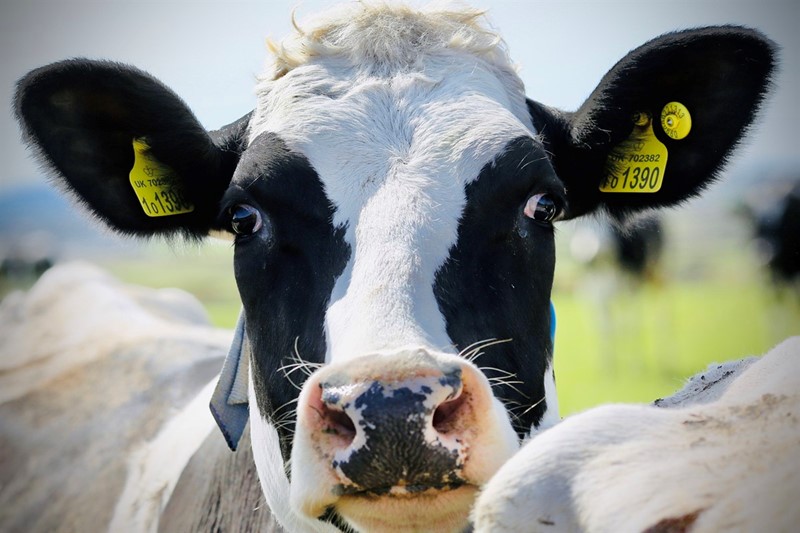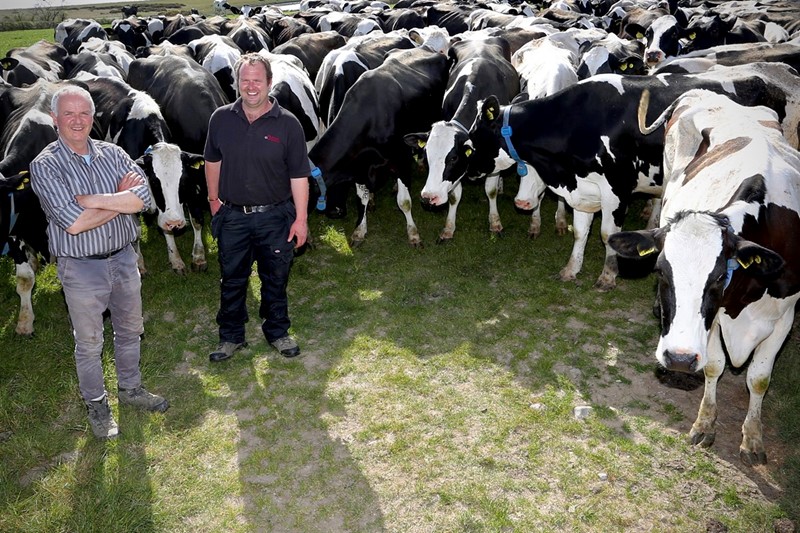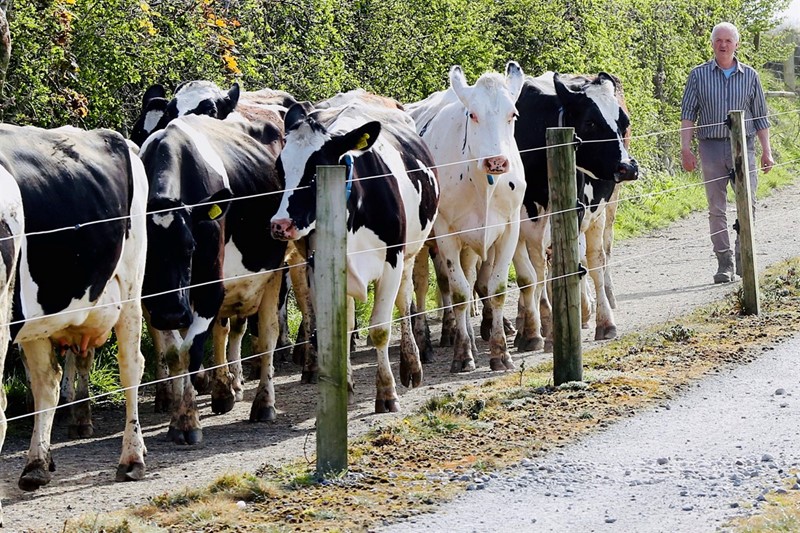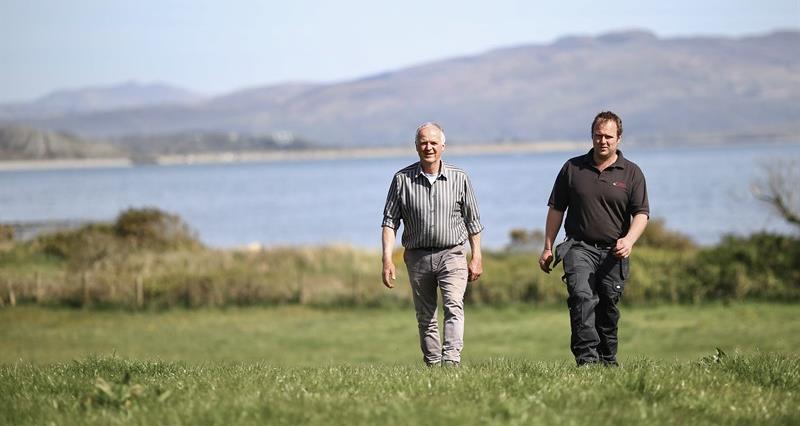Wise words spoken by his grandfather have served as a guiding light to John Hughes through some of the more turbulent periods in dairy farming.
“No matter what happens in the world, the world can’t do without agriculture,” Hugh Hughes told his grandson.
A simple observation but one that serves to remind John that dairy farming has a bright future, even at times when it has felt anything but.
“My grandfather was a wise man,” he says. “We have seen through this pandemic that the world needs farmers to produce food.”
He is reminded of the genuine fear at the start of the pandemic that prices of milk, beef and lamb would slump.
Not only did that not happen but the readjustment of prices went upwards. “Commodity prices are nearer to where they should be to reflect how much it costs farmers to produce those products,” says John.
He farms with his wife, Nerys, and their son and daughter-in-law, Sion and Elliw, at Ynysgain Fawr, a National Trust holding near Criccieth.
His grandparents first took on the tenancy in 1943, when the farm was in private ownership. At 110 acres it was at that time considered a big farm.

They moved there from a smallholding on the Llyn Peninsula and established a dairy herd. Milk has been produced at Ynysgain Fawr ever since.
John’s grandfather was a forward-thinking farmer, buying two farms adjacent to Ynysgain Fawr and taking on the tenancy of another holding.
John is the youngest of four children and always knew he wanted to farm.
“When I was 13 or 14, I would sit in on National Trust meetings with my grandfather and would take everything in. That put me in good stead.”
Both John and his brother, Hugh, wanted to farm. At that time his uncle, Humphrey, a bachelor, was farming Ynysgain Fawr. Since John’s parents’ business wasn’t big enough to support three families, he joined his uncle at Ynysgain Fawr.
It was 2001 when John took on the tenancy with his wife, Nerys, and Sion, now 31, has since joined them in the business; they also have a daughter, Mari, who is a social worker.
The family farms 265 acres of rented and owned land, producing milk from a pedigree Holstein Friesian herd.
Until recently milk production was based on an all-year-round calving pattern, targeting yields of 10,000 litres. But producing that milk came at a high cost. “We had to buy in a lot of feed,” John explains. “Whatever comes down the road in a lorry is a cost to the business.”
Ynysgain Fawr has the climate and soils to grow grass well so, to reduce costs, the system was overhauled to take advantage of those attributes. Calving was switched to an autumn block and a paddock grazing system was established to capture more milk from forage.
Cross-breeding has produced a hardier cow capable of yielding 8,000 litres of milk a year.
“It is a better way to farm, we are not pushing everything to the limit,” says John.
A reseeding programme has boosted grass quality and yield. This year, silage is being produced from a multi-cut system for the first time with the aim of producing consistent quality forage with a higher energy density and crude protein than the more traditional three-cut system.
Cuts will be taken monthly with five cuts targeted.
Grass availability was a challenge this year due to the cold and dry weather, but the conditions were right to take the first cut at the end of April.
With higher quality grass silage in the diet, the Hugheses will no longer grow wholecrop as they have done for the last 10 years.
Their herd is run as a closed unit with all replacements home-reared.
At its maximum, the holding has capacity to carry 180 cows, but John says the current herd size of 170 is a good number to make best use of grassland and facilities. “We don’t want to be stocked to the hilt,” he insists.
Cows are milked in a 20/40 rapid exit parlour, installed three years ago and paid for in part by a Sustainable Production Grant from the Welsh Government; this covered 40% of the cost.

“We priced everything up – a new parlour, concreting over the yards and putting in a new slurry pit. Thanks to the grant we were able to get all the work done for what we would have had to spend on the parlour,” John explains.
It incorporates the latest technology. Ear tags enable each cow to be identified as it enters the milking parlour while collar monitors gather data on how much they have been eating and how much milk they produce each day.
“The amount of feed they are given is adjusted accordingly to optimise the yield and the quality of the milk,” says John.
The system flags up if an animal is not well and automatically drafts cows that are bulling.
Data updates and behaviour alerts are fed through to the family’s smart phones.
John says the upgrade has made a significant difference to production and quality of life.
“It was taking Sion and I nearly nine hours a day to milk in the old parlour but now it is just three hours. You can’t put a price on the improvement that having the extra time in our day has made to our quality of life.”
The new slurry pit gives them sufficient capacity to meet Welsh Government’s new Nitrate Vulnerable Zone (NVZ) regulations without requiring further investment.
But John says the decision to make the whole of Wales an NVZ is nonsensical. “It will never work, if they push these things through it will be a disaster for the industry.
“Farming is not the problem. We are told that agricultural pollution accounts for 12% of all river pollution in Wales so where is the other 88% coming from and what is being done to deal with that?”
He supplies his milk to South Caernarfon Creameries and that has been the case since his grandfather first farmed at Ynysgain.
His grandfather was one of the first ever members to send milk to the creamery when it was established in 1938.

John says the co-operative structure is an important one in agriculture.
“South Caernarfon Creameries put a lot of farmers on their feet because before then there was no-one in the area to buy the milk.
“We own it as producers, and it’s been a blessing to a lot of farms.”
John, who turned 58 in May, says dairy farming has been tough for his generation but he is confident that better times lie ahead for the next generation.
Sion and his wife, Elliw, have three children, Iori, Marged and Elenid.
“There are good times to come. Our parents’ generation saw good times. Since I have been farming it has not been great, but I have taken every opportunity that has come my way.
“I am lucky that I have got my health and fitness and able to do everything but when I am in my sixties, I don’t want to be the main man, I want to let Sion get on with it and look from the side lines. Should something happen to me I know he would be able to run the farm.”
John says it is important for the older generation to recognise when it is time to let go. “It is sad to see young people not getting the chances that I had.
“If you have people in a position where they are not willing to adapt and change, young people will choose not to farm because there are now so many other options available to them.”
First published in Farming Wales July 2021
